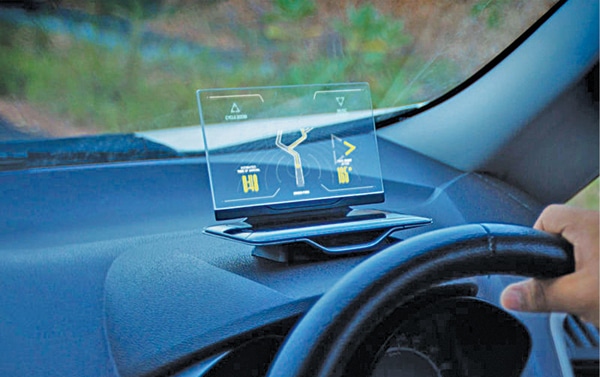The adoption of LCD technology in vehicular displays has happened quite quickly and smart displays have by now pretty much replaced the mechanical dashboards of yesteryears in cars. In an interview with our team, Rei Tjoeng from Sharp Devices revealed some interesting information regarding automotive-grade LCDs, the recent trends, and specific characteristics that make some LCD displays different from the others available in the market.

Q. How is the modernisation of 2- and 4-wheelers affecting the demand for LCD displays?
A. Adoption of TFT in 2-wheeler cluster applications has increased in a big way. The global automotive industry is widely believed to be on the cusp of tremendous change in terms of manufacturing, sales, and the overall business model, owing to the rapid advances in new-age technologies such as autonomous driving, augmented reality, and big data.
Visualisation technologies are the most vital components of in-vehicle interactions, with overall automotive navigation and connectivity characterising the cars of this generation.
Advanced driver-assistance systems (ADAS)—such as parking assistance, forward collision, lane-departure warnings, and blind-spot monitoring—are frequently hailed as the technologies that will usher us into an age of autonomous transportation, but drivers are still either untrusting or too trusting of these features. This has led to an evolution of sorts in the in-car user experience interfaces, and more so with the way automotive display makers are developing new products.
The future for ergonomic conformal displays, display-based dash, central console, in-door wing mirrors, and transparent displays that offer unobtrusive visual information during journeys is bright. Head-up displays are fast gaining popularity as an ideal interface for disseminating crucial information such as navigation messages, vehicle speed, and warnings.
Q. Are there any broad categories of LCD displays that are witnessing demand?
A. Yes, reflective LCDs, which use ambient light to reflect in order to read. In 2W cluster applications, where TFT is exposed to direct sunlight, readability is a major issue. Sharp Reflective LCD is a solution as visibility is crystal clear without any glare and is available in colour too. Equipped with a backlight, it can be used at night also.
Normal TFT has to pump more power through the backlight, which results in more power consumption and backlight life also gets affected to a large extent. This reflective LCD consumes very little power and could be the best fit-in product for the EV segment.
Q. One of the first fears that come to one’s mind when we see a large tablet-like display in cars is of its breaking. But what is the actual risk of these screens breaking?
A. The market is now shifting to large-size TFT displays in the automotive segment. These displays are automotive-grade LCDs and are tested for shock, vibration, high and low temperature, etc. For more protection and safety, glass bonding is done over TFT. Glass bonding with a cover glass on the LCD protects it from shock, as the hardened adhesive behind the glass acts as a shock absorber. Shakes and shocks are less likely to damage the display and glass, making this an important benefit for transportation applications. In the unlikely event that the glass is damaged, shards of broken glass will remain stuck to the optical adhesive.
Q. Reflection or glaring sunlight sometimes makes it difficult to read the displays. Any innovation introduced recently, or underway, that may solve this issue?
A. Reflective LCD and Progressive Super View are the two technologies which are effective under high ambient light. In progressive super view technology, internal and external reflection is cut down, which results in a clear view without glare. And the beauty of this technology is that it happens without pumping more power from the backlight. This helps in more lifetime of the backlight and less power consumption.
Reflective LCD is another technology that uses ambient light to reflect in order to read, hence there is more clarity under sunlight and very less power is needed. It is more beneficial for EV applications.
Q. How do LCDs combat the continuous temperature changes throughout the day, especially in automobiles?
A. Automotive-grade LCDs have strict requirements. The LCD must remain working during the extreme environment, for example, Indian summertime. For example, our LCDs are tested for storage temperature of -40 to 95°C and operating temperature of -30 to 85°C.
From a design engineer’s perspective, what are the top factors—besides the obvious ones like price, size, brand, after-support, etc—that should be borne in mind while selecting the right LCD panel?
There are a few LCD specs the design engineers need to consider at high priority when they select the LCD. The first specification will be the screen size and aspect ratio. The aspect ratio is the ratio between the length and width of the LCD. Some common ratios are 4:3, 5:4, 16:9, and so on. Of course, sometimes marketing people will also consider these specs as they will affect the whole outlook and design of the product.
Then the engineer may need to consider the LCD’s resolution and interface, whether they are matching with the motherboard. If the product is a semi-outdoor or outdoor application, then the engineer needs to also check the LCD’s brightness and operating temperature range, because these are very important specs if the product is located in the sunshine.
Design engineers can also refer to the box item titled ‘Selection Parameters for LCD Screens for Automotive Applications’ (see previous two pages).
Q. What are the common myths or missing info related to designing LCD screens for automotive solutions?
A. The smartphone has become very popular in recent years and it is influencing the engineers’ design. We saw some EV companies use the smartphone LCD as the cluster or GPS display for their first-generation products. The smartphone LCD is nice but, unfortunately, it is not designed for automotive applications, especially not for 2-wheeler outdoor usage. When the 2-wheeler is under the sunshine, the driver can barely see anything from the smartphone LCD. And, also, the smartphone LCD’s lifetime becomes much shorter under the automotive application scenario.
Q. How do you support customers, design engineers, and R&D teams during their initial stages of identifying the right LCD for their design?
A. Sharp Singapore has been in this region for many years. We understand our customers. First, our team will get the customer’s requirements from both the marketing and engineering sides. We will check the customer’s motherboard’s graphics capability, display interface, and other necessary technical details. We will propose the best suitable LCDs to the customer and explain the reason. We will explain what we observe from the market trend and help the customer to know the best options.
LCD samples and demo kits are available for the engineers to see the actual performance. There is also technical support available to help the design engineers to evaluate the LCD and design-in the LCD.

Q. Do you have some form of sampling programme for them to receive samples during their prototyping stages? Do you have development or evaluation kits for your LCD displays?
A. Sharp Singapore understands that samples and evaluation kits are important in the project’s early stage. Evaluation kits are available for the engineer to evaluate the LCD performance during the proof of concept stage. Then we will provide sample LCDs for the customer’s prototype builds.
Q. What is your support structure for design engineers in India?
A. We have salespersons stationed in India at New Delhi and Bangalore. They are working closely with the customers’ design engineers. There are technical support persons in Singapore and Japan. Our Indian team can support the customer onsite and bridge as technical person effectively between India and Singapore.
Q. Are we correct to assume that you supply the displays through major distributors or through your India office?
A. We have many distributors in India who can support the customer’s needs. Major OEMs are supported directly through our headquarters in Singapore.
For reading about various selection parameters for LCD screens for automotive applications: click here







Great Q&A.